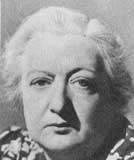Gladys Henson: Difference between revisions
JJMC89 bot (talk | contribs) |
Rescuing 1 sources and tagging 0 as dead. #IABot (v1.2.7.1) |
||
| Line 4: | Line 4: | ||
==Life and career== |
==Life and career== |
||
Henson was born '''Gladys Gunn''' in [[Dublin]], [[Ireland]].<ref>{{cite web |
Henson was born '''Gladys Gunn''' in [[Dublin]], [[Ireland]].<ref>{{cite web |
||
|url=http://www.probertencyclopaedia.com/CZ_GLADYS_HENSON.HTM |title=Gladys Henson |
|url=http://www.probertencyclopaedia.com/CZ_GLADYS_HENSON.HTM |
||
|title=Gladys Henson |
|||
|publisher= |
|publisher=The Probert Encyclopaedia of Actresses |
||
|accessdate=2009-04-23 |
|||
|deadurl=yes |
|||
|archiveurl=https://web.archive.org/web/20110608172549/http://www.probertencyclopaedia.com/CZ_GLADYS_HENSON.HTM |
|||
|archivedate=2011-06-08 |
|||
|df= |
|||
}}</ref> |
|||
She married English actor [[Leslie Henson]] in 1926 (they had a son [[Joe Henson|Joe]] in 1932). In 1932, she appeared in the premiere of [[Noël Coward]]'s ''[[Design for Living]]'' on Broadway, appearing in several other London and Broadway shows, including Coward's ''[[Set to Music]]'' (1939). After her divorce from Henson, she appeared in numerous well-known post-war films, often alongside [[Jack Warner (actor)|Jack Warner]], whose wife she played in both ''[[Train of Events]]'' and ''[[The Blue Lamp]]''; the scene in the latter in which her character learns of her husband's death has been described as "a masterpiece of understated emotion, moving without falling into sentimentality."<ref>{{cite web |url=http://www.screenonline.org.uk/film/id/447704/ |
She married English actor [[Leslie Henson]] in 1926 (they had a son [[Joe Henson|Joe]] in 1932). In 1932, she appeared in the premiere of [[Noël Coward]]'s ''[[Design for Living]]'' on Broadway, appearing in several other London and Broadway shows, including Coward's ''[[Set to Music]]'' (1939). After her divorce from Henson, she appeared in numerous well-known post-war films, often alongside [[Jack Warner (actor)|Jack Warner]], whose wife she played in both ''[[Train of Events]]'' and ''[[The Blue Lamp]]''; the scene in the latter in which her character learns of her husband's death has been described as "a masterpiece of understated emotion, moving without falling into sentimentality."<ref>{{cite web |url=http://www.screenonline.org.uk/film/id/447704/ |
||
|title=screenonline: Blue Lamp, The (1949) |publisher=[[British Film Institute]] |
|title=screenonline: Blue Lamp, The (1949) |publisher=[[British Film Institute]] |
||
Revision as of 15:43, 12 January 2017

Gladys Henson (27 September 1897 – 21 December 1982) was a British actress whose career lasted from 1932 to 1976 and included roles on stage, radio, films and television series. Among her most notable films were The History of Mr Polly (1949) and The Blue Lamp (1950).
Life and career
Henson was born Gladys Gunn in Dublin, Ireland.[1] She married English actor Leslie Henson in 1926 (they had a son Joe in 1932). In 1932, she appeared in the premiere of Noël Coward's Design for Living on Broadway, appearing in several other London and Broadway shows, including Coward's Set to Music (1939). After her divorce from Henson, she appeared in numerous well-known post-war films, often alongside Jack Warner, whose wife she played in both Train of Events and The Blue Lamp; the scene in the latter in which her character learns of her husband's death has been described as "a masterpiece of understated emotion, moving without falling into sentimentality."[2]
She died in London 21 December 1982 aged 85.
Partial filmography
Notable films and television programmes in which Henson appeared:
References
- ^ "Gladys Henson". The Probert Encyclopaedia of Actresses. Archived from the original on 2011-06-08. Retrieved 2009-04-23.
{{cite web}}: Unknown parameter|deadurl=ignored (|url-status=suggested) (help) - ^ "screenonline: Blue Lamp, The (1949)". British Film Institute. Retrieved 2009-04-23.
External links
